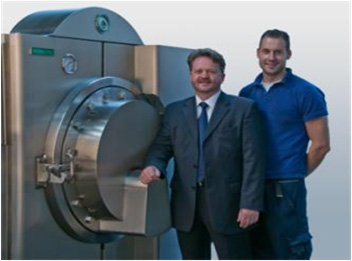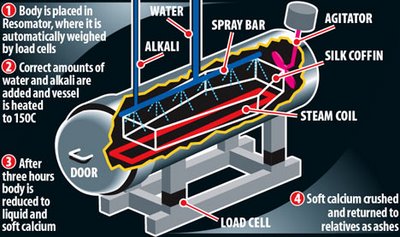The western way of dealing with death isn’t very ecofriendly. Burial, with its attendant casket and embalming, uses a lot of resources, takes up a lot of space, and results in a lot of chemicals being put into the ground. Cremation is almost as bad because it requires a huge amount of energy and releases serious amounts of toxins into the atmosphere. But a Scottish firm called Resomation Ltd. has been thinking outside of the box (and the oven) and has come up with an alternative called alkaline hydrolysis or “resomation” (derived from a Greek word meaning “rebirth of the body”).
“In the alkaline hydrolysis disposal process, the body is placed in a silk bag, itself placed within a metal cage frame. This is then loaded into a Resomator. The machine is filled with a mixture of water and lye, and heated to a high temperature (around 160°C [320°F]), but at a high pressure, which prevents boiling. Instead, the body is effectively broken down into its chemical components, which takes about three hours. The end result is a quantity of green-brown tinted liquid (containing amino acids, peptides, sugars and salts) and soft, porous white bone remains (calcium phosphate) easily crushed in the hand (although a cremulator is more commonly used) to form a white-colored dust. The “ash” can then be returned to the next of kin of the deceased. The liquid is disposed of either through the sanitary sewer system, or through some other method including use in a garden or green space. This alkaline hydrolysis process is currently being championed by a number of ecological campaigning groups for using less energy and producing less carbon dioxide and pollutants than cremation” (source).
Literally “going green” via resomation is legal and growing in popularity in the United Kingdom which is short on burial space and where up to 16% of all mercury is estimated to be emitted from crematoria because of the fillings in teeth. In the U.S. (where funeral homes bury 1.6 million tons of reinforced concrete, 827,060 tons of toxic embalming fluid, 90,000 tons of casket steel, and 30 million tons of hardwood board each year [source]), the process is currently legal in Colorado, Florida, Maine, Oregon, Maryland, and Minnesota, as well as in several other states which allow hospitals and clinics to use an alkaline hydrolysis process to dispose of donated bodies (click here for more about legislation). If you’re dying to be green, il faut cultiver notre jardin, as Voltaire pointed out.
Article by Bill Norrington



